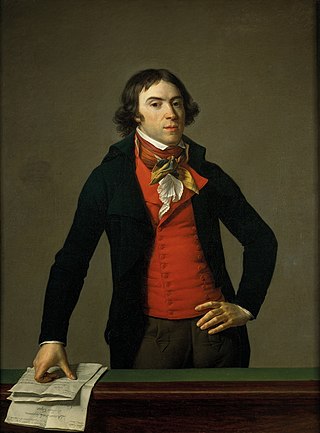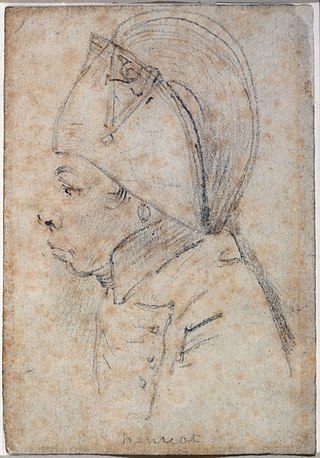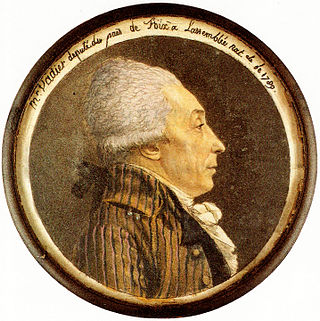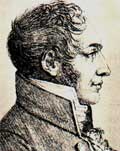Related Research Articles

The Reign of Terror was a period of the French Revolution when, following the creation of the First Republic, a series of massacres and numerous public executions took place in response to revolutionary fervour, anticlerical sentiment, and accusations of treason by the Committee of Public Safety.

Bertrand Barère de Vieuzac was a French politician, freemason, journalist, and one of the most prominent members of the National Convention, representing the Plain during the French Revolution. The Plain was dominated by the radical Montagnards and Barère as one of their leaders supported the foundation of the Committee of Public Safety in April and of a sans-culottes army in September 1793. According to Francois Buzot, Barère was responsible for the Reign of Terror, like Robespierre and Louis de Saint-Just. In Spring 1794 and after the Festival of the Supreme Being, he became an opponent of Maximilien Robespierre and joined the coup, leading to his downfall.

Georges Jacques Danton was a French lawyer and a leading figure in the French Revolution. He became a deputy to the Paris Commune, presided in the Cordeliers district, and visited the Jacobin club. In August 1792 he became French Minister of Justice and was responsible for inciting the September Massacres. In Spring 1793 he supported the foundation of a Revolutionary Tribunal and became the first president of the Committee of Public Safety. Georges Jacques Danton was a key figure in the case of Dumouriez. After the Insurrection of 31 May – 2 June 1793 he changed his mind on the use of force and lost his seat in the committee; Danton and Robespierre became rivals. In early October 1793, he left politics but was urged to return to Paris to plead, as a moderate, for an end to the Terror. Danton's continual criticism of the Committee of Public Safety provoked further counter-attacks. At the end of March 1794, Danton made a speech announcing the end of the Terror. Within a week, he became embroiled in a scandal concerning the bankruptcy proceedings of the French East India Company and was guillotined by the advocates of revolutionary terror after accusations of conspiracy, venality and leniency toward the enemies of the Revolution.

Antoine Quentin Fouquier de Tinville was a French lawyer and public prosecutor during the French Revolution and Reign of Terror.

The Mountain was a political group during the French Revolution. Its members, called the Montagnards, sat on the highest benches in the National Convention.

Jacques-Nicolas Billaud-Varenne, also known as Jean Nicolas or by his nickname, the Righteous Patriot, was a French personality of the Revolutionary period. Jacques Nicolas Billaud-Varenne was an instrumental figure of the period known as the Reign of Terror. Billaud-Varenne climbed his way up the ladder of power during that period, becoming one of the most militant members of the Committee of Public Safety. He was recognized and worked with French Revolution figures Georges Danton and Maximilien Robespierre, and is often considered one of the key architects of The Terror. "No, we will not step backward, our zeal will only be smothered in the tomb; either the Revolution will triumph or we will all die."
In the historiography of the French Revolution, the Thermidorian Reaction is the common term for the period between the ousting of Maximilien Robespierre on 9 Thermidor II, or 27 July 1794, and the inauguration of the French Directory on 2 November 1795.

Jean-Lambert Tallien was a French politician of the revolutionary period. Though initially an active agent of the Reign of Terror, he eventually clashed with its leader, Maximilien Robespierre, and is best known as one of the key figures of the Thermidorian Reaction that led to the fall of Robespierre and the end of the Terror.

The September Massacres were a series of killings of prisoners in Paris that occurred in 1792, from Sunday, 2 September until Thursday, 6 September, during the French Revolution. Between 1,176 and 1,614 people were killed by fédérés, guardsmen, and sans-culottes, with the support of gendarmes responsible for guarding the tribunals and prisons, the Cordeliers, the Committee of Surveillance of the Commune, and the revolutionary sections of Paris.

François Hanriot was a French Sans-culotte leader, street orator, and commander of the Garde Nationale during the French Revolution. He played a vital role in the Insurrection of 31 May – 2 June 1793 and subsequently the fall of the Girondins. On 27 July 1794 he tried to release Maximilien Robespierre, who was arrested by the Convention. He was executed on the next day – together with Robespierre, Saint-Just and Couthon – by the rules of the law of 22 Prairial, only verifying his identity at the trial.

Marc-Guillaume Alexis Vadier was a major French politician of the French Revolution. He is sometimes called the "Great Inquisitor", for his active participation in the Reign of Terror. During this time, he was in charge of the Comité de Sûreté Générale, which was tasked with the prosecution of the so-called enemies of the Revolution. He is probably one of the main actors in the fall of Robespierre, which was his political rival.

Maurice Duplay was a French carpentry contractor and revolutionary in the French Revolution. In September 1793 he became a member of the Revolutionary Tribunal. He was landlord to Maximilien de Robespierre, Charlotte Robespierre, Augustin Robespierre and Georges Couthon.

Maximilien François Marie Isidore de Robespierre was a French lawyer and statesman who became one of the best-known, influential, and controversial figures of the French Revolution. As a member of the Estates-General, the Constituent Assembly, and the Jacobin Club, he campaigned for universal manhood suffrage, the right to vote for people of color, Jews, actors, and domestic staff, and the abolition of both clerical celibacy and French involvement in the Atlantic slave trade. In 1791, Robespierre was elected as "public accuser" and became an outspoken advocate for male citizens without a political voice, for their unrestricted admission to the National Guard, to public offices, and to the commissioned ranks of the army, for the right to petition and the right to bear arms in self defence. Robespierre played an important part in the agitation which brought about the fall of the French monarchy on 10 August 1792 and the convocation of the National Convention. His goal was to create a one and indivisible France, establish equality before the law, abolish prerogatives, and defend the principles of direct democracy. He earned the nickname "the incorruptible" for his adherence to strict moral values.
François Louis Michel Chemin des Forgues was a French politician, and Foreign Minister.

Martial Joseph Armand Herman (guillotined), was a lawyer and a chief judge during the Reign of Terror. His most famous cases were against Marie Antoinette and Georges Danton. As the commissioner of police he dealt with the Luxembourg prison conspiracies, shortly before the Jacobin regime fell.

Jacques-Alexis Thuriot, known as Thuriot de la Rosière, and later as chevalier Thuriot de la Rosière, chevalier de l'Empire was an important French statesman of the French Revolution, and a minor figure under the French Empire of Napoleon Bonaparte.
René-François Dumas, born 14 December 1753 in Jussey, in the bailiwick of Amont, was a revolutionary French lawyer and politician, regarded as a "Robespierrist", who died on 28 July 1794 at Paris.
Laurent Lecointre was a French politician, born at Versailles on 1 February 1742, and died at Guignes, Seine-et-Marne on 4 August 1805. He is also known under the name of "Lecointre de Versailles".
Antoine Marie Charles Garnier called "Garnier de l'Aube", born on 7 September 1742 in Troyes and died on 9 September 1805 at Blaincourt-sur-Aube (Aube), was a politician during the French Revolution. He took part in the coup, organized by Laurent Lecointre, etc. which led to the Fall of Robespierre. According to some authors, he was the one who launched on 9 Thermidor, when Robespierre was temporarily unable to speak: "It is the blood of Danton that chokes you!". The sentence, however, is sometimes attributed to Louis Legendre. During the Directoire he was a member of the Conseil des Cinq-Cents.
References
- ↑ Documents intéressant E.B. Courtois. In: Annales historiques de la Révolution française, 55e Année, No. 254 (Octobre-Décembre 1983), pp. 624-628
- ↑ Conjuration formée dès le 5 préréal [sic] par neuf représentans du peuple contre Maximilien Robespierre, pour le poignarder en plein sénat : rapport et acte d'accusation dont la lecture devoit précéder dans la Convention cet acte de dévouement / by Lecointre, Laurent, d. 1805
- ↑ The Last Days of Marie Antoinete: From the French of G. Lenôtre
- ↑ Papiers inédits trouvés chez Robespierre, Saint-Just, Payan, etc. supprimés ... by Edme-Bonaventure Courtois, Maximilien de Robespierre (1828)
- ↑ Ratineau Fabienne. Les livres de Robespierre au 9 thermidor. In: Annales historiques de la Révolution française, n°287, 1992. pp. 131-135. DOI : https://doi.org/10.3406/ahrf.1992.1479www.persee.fr/doc/ahrf_0003-4436_1992_num_287_1_1479
- ↑ One hundred and twenty-six pages of Robespierre
- ↑ Colin Jones (2015) 9 Thermidor: Cinderella among Revolutionary Journées. In: French Historical Studies 38 (1): 9-31
- ↑ Biographien und Charakteristiken. Band 4, p. 172
- ↑ Catalogue des livres composant la bibliothèque de feu M. Edme-Bonaventure
- ↑ Biographien und Charakteristiken. Band 4, p. 172
- ↑ A Letter from Danton to Marie-Antoinette
- ↑ "Histoire de la Bibliophilie: La Bibliothèque Courtois, ou les Origines suspectes d'une riche bibliothèque révolutionnaire". 15 December 2012.